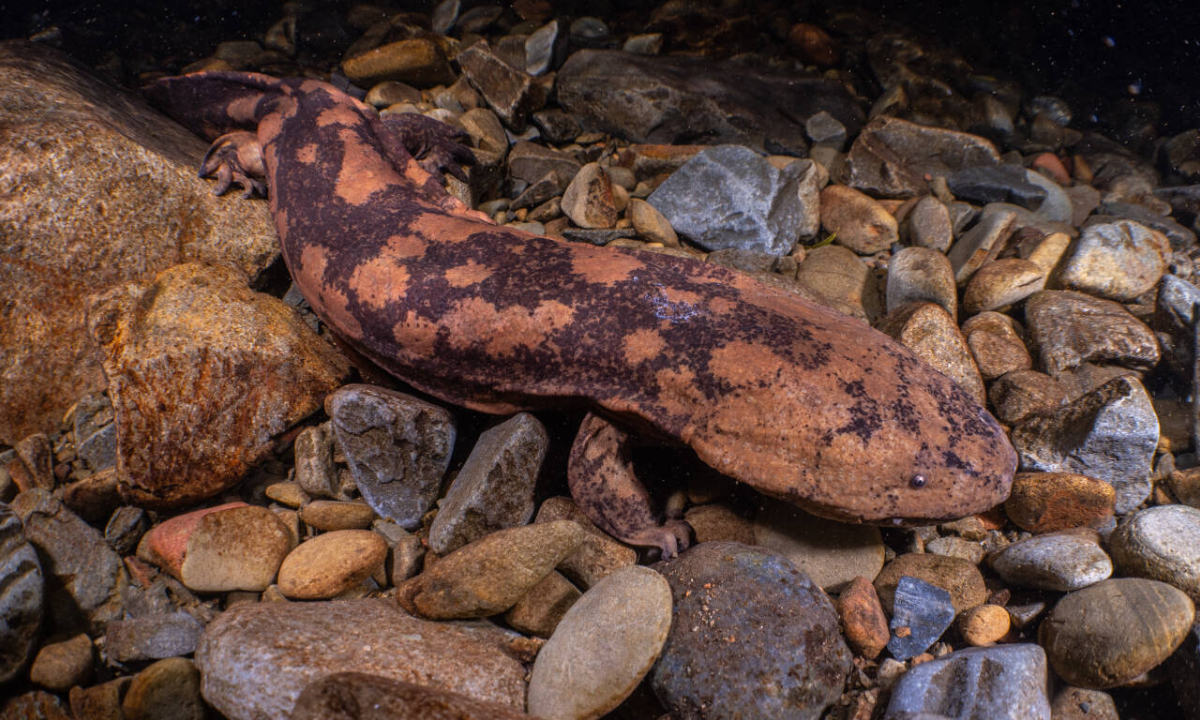
Photo: sciencenet.cn
Chinese researchers recently published a first data report on the living habits,
mk population reproductive dynamics, and habitat conditions of the wild giant salamander, an amphibian species. The report shows that the Jiangxi giant salamanders (Andrias jiangxiensis) face multiple threats, including natural threats from habitat environmental changes and human-induced threats.
The researchers developed a long-term monitoring work plan and strategy to collect basic biological and habitat ecological data for the species, which face the risks of aging and declining. Researchers hope it to serve as an important basis for assessing their endangered status and formulating corresponding conservation action plans.
Four years ago, the research team under the leadership of Che Jing, a fellow researcher from Kunming Institute of Zoology, Chinese Academy of Sciences, discovered the first pure wild population of giant salamanders in Jiangxi Jiulingshan National Nature Reserve in East China’s Jiangxi Province. The research team then named it the Jiangxi giant salamander in 2022 based on its genetic differentiation and morphological evidence, China Science Daily reported.
After that, the research team conducted a three-year-long monitoring of both population ecology and habitat of the wild population of the Jiangxi giant salamander in the Jinjia tributary of the Beiliao River in Jiangxi, and has their research result published in the Biodiversity Science, a Chinese nationwide academic journal. The research has provided important data and reference for the in-situ conservation of wild populations of Jiangxi giant salamanders and other giant salamander species in China.
Researches show that giant salamanders with the titles of “living fossil” and “panda living in the water” originated in the Jurassic period were once widely distributed in 17 provinces across China. The species is currently listed as national second-class protected wild animals and is classified as a critically endangered species by the International Union for Conservation of Nature, according to China Science Daily.
Since the 1950s, the population of wild Chinese giant salamanders has sharply declined, and become extremely rare due to habitat loss, climate change and human capture.
According to Che, there are so far four officially named species of Chinese giant salamanders including the Jiangxi giant salamander. However, except for the Jiangxi giant salamander, the distribution and population sizes of other named and undescribed species of Chinese giant salamanders remain unknown, making it difficult for the conservation of the animal to be implemented.
The key to overcoming challenges in conserving the Chinese giant salamander lies in finding pure and non-hybridized native giant salamander populations and determining the distribution and endangered status of each species. Between 2013 and 2016, domestic and international scholars organized field surveys at 97 distribution sites in 16 provinces across China and only find 24 wild giant salamanders at four of those sites, according to China Science Daily.
The research team led by Che found and identified some individual giant salamanders in the key nature reserves and surrounding areas, and determined whether the salamanders were purebred based on their nuclear genome. In September of 2020, the research team found the purebred giant salamanders in the Jiangxi Jiulingshan National Nature Reserve.
Through monitoring and estimation, the team found that the population of the Jiangxi giant salamander has approximately 474 individuals, with a population density of 79 individuals per square kilometer. Besides, individuals of the Jiangxi giant salamander shorter than 30 centimeters and longer than 70 centimeters are very rare. If such a status remains for a long time, the Jiangxi giant salamander population will potentially face the risks of aging and declining, according to the research team.
Based on their research, the researchers found that the Jiangxi giant salamanders are currently only distributed in the Jinjia tributary of the Beiliao River in Jiangxi and exists as a small, isolated population. The area of their water habitat is limited, and they face multiple threats, including natural threats from habitat environmental changes and human-induced threats.
The research team has developed a long-term monitoring work plan and strategy to systematically collect basic biological and habitat ecological data for the species, which Che said will serve as an important basis for assessing their endangered status and formulating corresponding conservation action plans.
Based on the current population status and relevant assessment criteria, the researchers recommend classifying the Jiangxi giant salamander as a critically endangered species and listing the wild animals as national first-class protected wild animals.
Global Times

